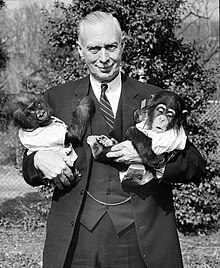Hominine
| Homininae Temporal range: 23.03–0 Ma |
|
|---|---|
 |
|
| A human holding a young gorilla and a young chimpanzee, three hominines. | |
| Scientific classification | |
| Kingdom: | Animalia |
| Phylum: | Chordata |
| Class: | Mammalia |
| Order: | Primates |
| Suborder: | Haplorhini |
| Family: | Hominidae |
| Subfamily: |
Homininae Gray, 1825 |
| Tribe | |
|
†Pierolapithecus |
|
†Pierolapithecus
†Udabnopithecus
†Dryopithecini
Gorillini
Hominini
Homininae is a subfamily of Hominidae.
It includes two tribes, with their extant as well as extinct species: the Hominini tribe (with the genus Homo including modern humans, and the genus Pan including chimpanzees and bonobos), and the Gorillini tribe (gorillas). It comprises all hominids that arose after orangutans (subfamily Ponginae) split from the line of great apes. The Homininae cladogram has three main branches, which lead to gorillas (through the tribe Gorillini), and to humans and chimpanzees via the tribe Hominini and subtribes Hominina and Panina (see the evolutionary tree below). There are two living species of Panina (chimpanzees and bonobos) and two living species of gorillas, but only one extant human species. Traces of hypothetical Homo species, including Homo floresiensis and Homo denisova, have been found with dates as recent as 12,000 years ago. Organisms in this class are described as hominine or hominines (not to be confused with the terms hominins or hominini).
Until 1980, the family (and term) Hominidae meant humans only; the non-human great apes were assigned to the family Pongidae. Later discoveries led to revised classifications, with the great apes then united with humans (now in subfamily Homininae) as members of family Hominidae Further discoveries indicated that gorillas and chimpanzees are more closely related to humans than they are to orangutans, leading to their (gorillas and chimpanzees) placement in subfamily Homininae as well.
...
Wikipedia
